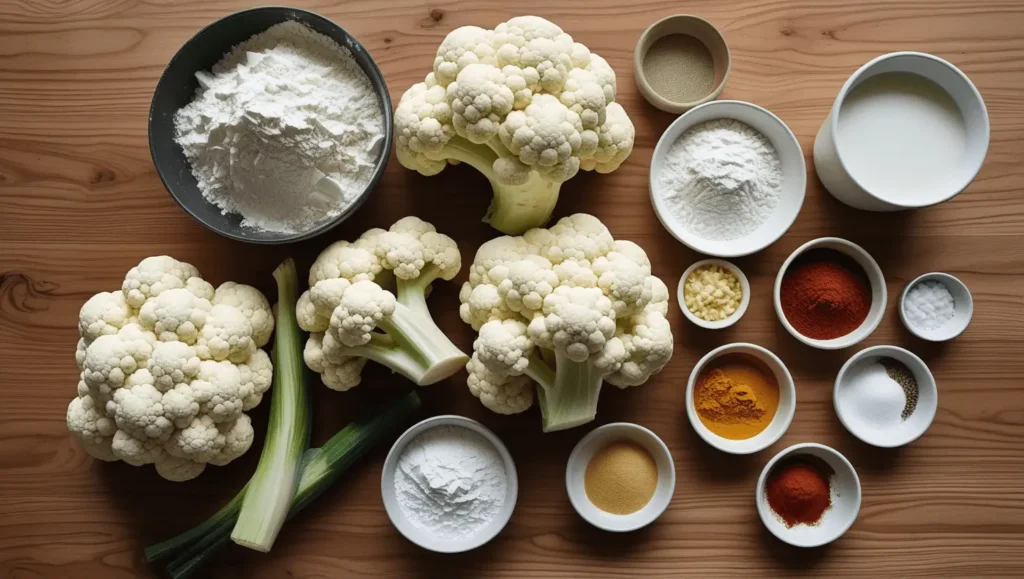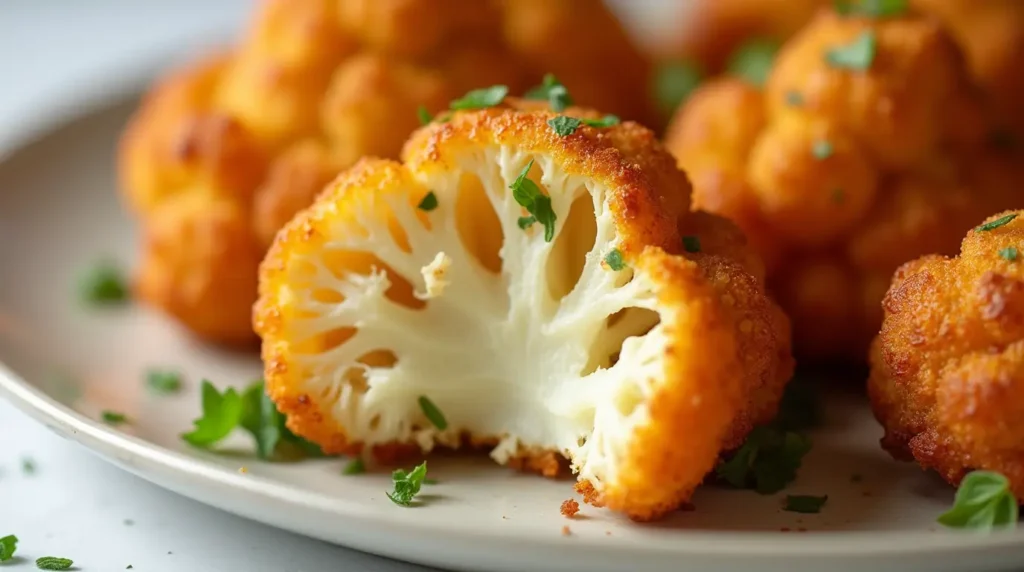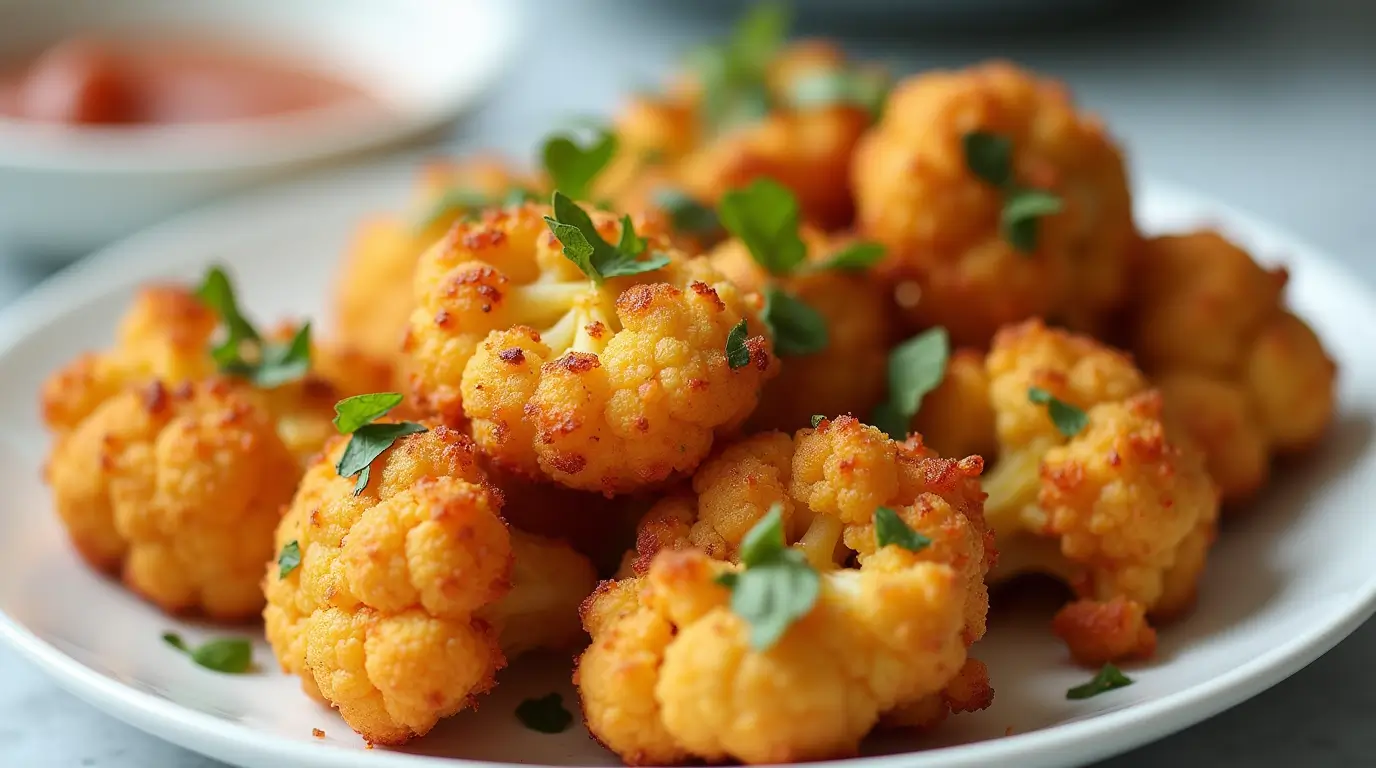This Vegan Fried Cauliflower Recipe is the perfect combination of crispy, golden-brown florets with a mouthwatering, flavorful crunch that will have you coming back for more. Whether you’re looking for a delicious appetizer, a side dish, or a vegan alternative to chicken wings, this recipe is your go-to for all occasions. Easy to make, totally plant-based, and incredibly satisfying, it promises to wow your guests and delight your taste buds.
Introduction
If you’ve been craving something crispy, flavorful, and healthy, this Vegan Fried Cauliflower Recipe is the answer. A perfect blend of savory spices, crispy batter, and tender cauliflower, this dish is so much more than just a side dish—it’s a star. Whether you’re a long-time vegan or simply looking to try a meatless meal, this recipe offers all the taste without any of the guilt. The satisfying crunch and the subtle flavors of cauliflower make this dish an irresistible favorite among both plant-based eaters and non-vegans alike.
In addition to its delicious flavor, this Vegan Fried Cauliflower Recipe is incredibly versatile. You can easily make it as a snack, serve it as an appetizer at your next lunch party, or pair it with a hearty salad for a complete meal. The recipe is also highly adaptable—feel free to experiment with the spices to suit your taste preferences. Plus, it’s a great way to enjoy cauliflower in a completely new light! This recipe is quick to prepare, simple to cook, and makes a great addition to any meal, ensuring you’ll be reaching for it time and time again.
Table of Contents
Key Takeaways
- Taste: This Vegan Fried Cauliflower Recipe features crispy, golden-brown cauliflower with a perfect blend of savory spices that are sure to please any palate.
- Dietary Considerations: It is 100% plant-based, dairy-free, gluten-free (when using gluten-free flour), and soy-free. A perfect option for those with dietary restrictions.
- Ease and Versatility: The recipe is easy to follow and can be made in under an hour. You can serve it with a variety of dipping sauces or use it as a filling for wraps and tacos.
Recipe Card
| Prep Time | 15 minutes |
|---|---|
| Cook Time | 20 minutes |
| Total Time | 35 minutes |
| Servings | 4 servings |
| Calories per Serving | 180 calories |
Ingredients
| Ingredient | Quantity | Notes |
|---|---|---|
| Cauliflower florets | 1 medium head | Cut into bite-sized florets |
| All-purpose flour | 1 cup | Can substitute with chickpea flour for gluten-free |
| Cornstarch | 2 tablespoons | For extra crispiness |
| Plant-based milk | 1 cup | Use almond or oat milk for best flavor |
| Garlic powder | 1 teaspoon | Fresh garlic can be used as an alternative |
| Onion powder | 1 teaspoon | |
| Smoked paprika | 1 teaspoon | Optional, for a smoky flavor |
| Salt | ½ teaspoon | Adjust to taste |
| Black pepper | ¼ teaspoon | |
| Baking powder | 1 teaspoon | Helps to make the batter lighter |
| Oil (for frying) | As needed | Use vegetable or canola oil |

Step-by-Step Recipe Instructions for Vegan Fried Cauliflower
Step 1: Prepare the Cauliflower
Slice the cauliflower into small, bite-sized florets, ensuring they are of uniform size for even cooking.
Tip: If you have a large head of cauliflower, divide it into florets and then cut each into halves or quarters to make them more manageable.
Step 2: Make the Batter
Instructions:
In a large mixing bowl, whisk together the flour, cornstarch, garlic powder, onion powder, smoked paprika, baking powder, salt, and black pepper. Slowly pour in the plant-based milk, whisking continuously until you achieve a smooth batter. The batter should be thick enough to fully coat the cauliflower florets in a uniform layer.
Tip: For extra crunch, you can add a bit more cornstarch to thicken the batter even further.
Step 3: Heat the Oil
Instructions:
In a large frying pan or pot, heat about 2-3 inches of oil over medium-high heat. To check if the oil is ready, drop a small spoonful of batter into the pan. If the oil sizzles as soon as the cauliflower touches it, the temperature is just right.
Tip: Keep the oil at a steady temperature to avoid soggy cauliflower. If the oil is too hot, the cauliflower will burn, and if it’s too cold, it will absorb too much oil.
Step 4: Coat and Fry the Cauliflower
Instructions:
Coat each cauliflower floret thoroughly in the batter, then gently place it into the hot oil. Fry in batches to avoid overcrowding. Cook the florets for 3-4 minutes on each side, or until golden brown and crispy. Once done, remove from the oil and place it on a paper towel-lined plate to drain any excess oil.
Tip: You can use tongs or a slotted spoon to carefully turn the florets, ensuring they cook evenly on all sides.
Step 5: Serve and Enjoy
Instructions:
Once all the florets are fried, serve them hot with your favorite dipping sauce, such as vegan ranch, barbecue sauce, or a tangy buffalo sauce. Garnish with fresh parsley or green onions for an added pop of color and flavor.
Tip: For a fun twist, try adding a drizzle of lemon juice or hot sauce right before serving.
Notes
- Substitutions: You can use chickpea flour instead of all-purpose flour for a gluten-free version. Additionally, try using different plant-based milks (such as soy or cashew milk) to alter the flavor slightly.
- Dipping Sauces: Pair the fried cauliflower with a variety of sauces such as spicy mayo, vegan ranch, or a tangy garlic sauce. You can even create a dipping station for guests to enjoy different flavors!
- Storage: Leftover fried cauliflower can be stored in an airtight container in the fridge for up to 3 days. To reheat, place it on a baking sheet in a preheated oven at 350°F for 10 minutes for a crispier texture.
Nutrition Information
| Nutrient | Amount per Serving |
|---|---|
| Calories | 180 |
| Total Fat | 9g |
| Saturated Fat | 1g |
| Cholesterol | 0mg |
| Sodium | 290mg |
| Total Carbohydrates | 24g |
| Dietary Fiber | 3g |
| Sugars | 2g |
| Protein | 4g |
Tools and Equipment Needed
| Equipment | Purpose |
|---|---|
| Mixing bowls | For combining ingredients |
| Whisk | To mix the batter |
| Frying pan or pot | For frying the cauliflower |
| Tongs or slotted spoon | For turning the cauliflower during frying |
| Measuring cups/spoons | For accurate ingredient measurement |
The History of Recipe
The history of fried cauliflower dates back centuries, with variations found in numerous cuisines across the world. Originating in the Mediterranean, cauliflower has long been appreciated for its versatility and nutritional value. In Mediterranean and Middle Eastern cuisines, cauliflower was often prepared in stews, roasted, or fried, becoming a staple in vegetarian diets long before plant-based eating became a trend. The evolution of fried cauliflower into a crispy, batter-coated dish can be traced back to the growing popularity of frying techniques and breading methods in Western kitchens.
Over time, the dish began to gain prominence in other parts of the world, especially as vegan and plant-based diets grew in popularity. In the U.S., the dish became a favorite substitute for traditional fried chicken, often served at gatherings or as a comfort food alternative. Today, vegan fried cauliflower has taken on a life of its own, with endless flavor possibilities and a growing place in both home kitchens and restaurants. Its crispy texture, rich flavor, and easy preparation make it an enduring favorite among all kinds of eaters.

Common Mistakes to Avoid
When preparing this dish, there are a few common mistakes that can affect the final result. One of the most common issues is overcooking the cauliflower, which can cause it to become too soft or even burnt. To avoid this, be sure to keep an eye on the florets while frying and adjust the heat as needed to ensure they cook evenly. Additionally, it’s essential to avoid overcrowding the pan while frying. This may result in uneven cooking and cause the cauliflower to become soggy. Fry in batches to maintain the perfect texture.
Another common mistake is using the wrong flour-to-liquid ratio for the batter. If the batter is too thin, it will not adhere properly to the cauliflower and may result in a soggy exterior. Conversely, if it’s too thick, the cauliflower will be overwhelmed by the batter and may not cook properly. To prevent this, ensure you’re adding the plant-based milk gradually and stopping once the batter reaches a smooth, thick consistency that still coats the cauliflower evenly.
Why You’ll Love This Recipe
- Flavor Profile: The flavor of vegan fried cauliflower is simply irresistible. The cauliflower’s natural subtle taste combines perfectly with the savory spices and crispy batter. The result is a light and crispy texture on the outside with a soft, tender interior. Each bite is packed with flavor, and the seasonings give it a delightful zing that keeps you coming back for more.
- Ease of Preparation: This recipe is incredibly simple to make, requiring only basic ingredients and easy-to-follow steps. The process is straightforward, and with minimal prep time, you’ll have a satisfying dish ready in under 40 minutes. Whether you’re cooking for yourself or a group, this recipe is a quick solution to cravings for comfort food.
- Versatility: Vegan fried cauliflower can be served in many ways, making it perfect for a wide range of occasions. Serve it as an appetizer with dipping sauces, pair it with a fresh salad for a light meal, or enjoy it as a snack for any time of day. The flavor can also be easily adjusted by modifying the spices or adding sauces like buffalo or BBQ to suit your mood.
Key Ingredients and Substitutions
- Cauliflower: The star ingredient, cauliflower provides a mild flavor and hearty texture that holds up well when fried. If cauliflower is unavailable, you could try broccoli, Brussels sprouts, or even zucchini as a substitute.
- All-Purpose Flour: This is the base for the batter, giving the cauliflower its crispy coating. If you’re gluten-free, opt for chickpea flour or a gluten-free flour blend.
- Plant-Based Milk: The milk helps create a smooth batter. Almond milk, oat milk, or soy milk are excellent alternatives. If you’re not concerned about keeping it dairy-free, you can also use regular milk.
- Cornstarch: This ingredient is essential for achieving the perfect crispy texture. If you don’t have cornstarch, potato starch can be used as a substitute.
- Baking Powder: It helps make the batter light and airy. If you don’t have it, you can skip it, but the texture may be slightly denser.
Culinary Magic: The Pleasure of Making This Recipe
The magic of making this vegan fried cauliflower lies in the transformation of humble ingredients into a crispy, golden delight. Each step—from dipping the cauliflower into the batter to watching it bubble away in the hot oil—creates anticipation and excitement. The result is a satisfying, addictive dish that is sure to impress. The joy of preparing this dish is amplified by its versatility, allowing you to experiment with different spices and sauces.
Troubleshooting Common Issues
Problem: The cauliflower isn’t crisping up properly.
Solution: Make sure the oil is at the right temperature before frying. If it’s too cool, the batter will absorb more oil and turn soggy. You can also double-coat the cauliflower in batter for an extra crispy finish.
Problem: The batter isn’t sticking to the cauliflower.
Solution: Ensure the cauliflower florets are dry before dipping them in the batter. Moisture on the cauliflower can cause the batter to slide off. For better adhesion, try lightly dusting the cauliflower in flour before dipping it into the batter.
Expert Tips for Success
To achieve the best results when making this recipe, use high-quality plant-based milk like almond or oat milk for a richer flavor. Also, for the crispiest outcome, use vegetable or canola oil with a high smoking point, and maintain a consistent temperature. If you want to give your cauliflower an even crispier texture, try adding a bit more cornstarch to the batter or double-coating the florets. Finally, don’t skip the baking powder—it’s key to achieving the light, airy texture that makes this dish so irresistible.
Variations and Customizations
For a spicier kick, you can add a dash of cayenne pepper or chili flakes to the batter. For a smoky flavor, smoked paprika is a fantastic addition. If you want to make the dish even heartier, toss the cauliflower in your favorite sauce—like buffalo, BBQ, or sriracha—after frying. For a gluten-free version, substitute the all-purpose flour with chickpea flour or a gluten-free flour blend. To make it soy-free, check that your plant-based milk is soy-free and opt for a non-soy option.
Storing Leftovers (Refrigeration/Freezing)
To store leftover fried cauliflower, place it in an airtight container and refrigerate for up to 3 days. For longer storage, freeze the fried florets on a baking sheet, and once frozen, transfer them to a zip-top bag or airtight container. To reheat, bake the cauliflower in a preheated oven at 375°F for 10-15 minutes to restore its crispy texture. Refrain from microwaving, as it can make the cauliflower soggy.
Serving Suggestions
Vegan fried cauliflower is delicious on its own or as part of a larger meal. For a balanced meal, serve it with a fresh green salad, quinoa, or roasted vegetables. Pair it with a creamy dipping sauce like vegan ranch or a tangy spicy buffalo sauce. If you’re serving it as an appetizer or party snack, offer a variety of sauces, such as barbecue sauce, garlic aioli, or a cool cucumber dip. This dish also pairs well with a refreshing drink like iced tea, lemonade, or a light, crisp beer.
Frequently Asked Questions
Can I make this recipe gluten-free?
Yes! To make this vegan fried cauliflower recipe gluten-free, simply substitute the all-purpose flour with chickpea flour or a gluten-free flour blend. Make sure to check that your plant-based milk is also free of any gluten-containing ingredients. For extra crispiness, consider using potato starch in place of cornstarch.
Can I bake the cauliflower instead of frying it?
Absolutely! If you prefer a healthier option or want to avoid frying, you can bake the cauliflower. Preheat your oven to 400°F (200°C), and arrange the battered cauliflower florets on a baking sheet lined with parchment paper. Lightly spray them with oil and bake for 25-30 minutes, flipping halfway through, until golden and crispy. While it may not have the same texture as frying, it’s still delicious and crispy!
How can I make this dish spicier?
To make the fried cauliflower spicier, you can adjust the seasoning in the batter. Add cayenne pepper or red pepper flakes to the flour mixture, depending on your heat tolerance. You can also toss the fried cauliflower in a spicy sauce like buffalo sauce or sriracha for an extra kick. Just be sure to taste as you go to find the perfect level of spice!
What can I serve this with?
Vegan-fried cauliflower pairs well with a variety of sides and dips. You can serve it with a fresh salad, roasted vegetables, or a grain like quinoa or rice for a complete meal. For dipping, try vegan ranch, barbecue sauce, garlic aioli, or even a tangy hot sauce. It’s also a great appetizer for a party, especially when paired with multiple dipping options for guests to choose from.
Can I store and reheat leftovers?
Yes, you can store leftovers! Place the fried cauliflower in an airtight container and refrigerate for up to 3 days. To reheat, place the cauliflower in a preheated oven at 375°F (190°C) for about 10-15 minutes to restore the crispy texture. Avoid microwaving, as this can make the cauliflower soggy. If you have leftover cauliflower and want to freeze it, spread the florets on a baking sheet and freeze them individually before transferring them to a freezer-safe bag or container.
Related Recipes
If you love the crispy, flavorful delight of vegan fried cauliflower, you might also enjoy these related recipes that offer similar textures, flavors, or cooking techniques:
- Vegan Cauliflower Wings: A perfect alternative to buffalo wings, these crispy cauliflower pieces are coated in a spicy, tangy sauce and make for a great party snack or game-day treat.
- Vegan Tempura Vegetables: If you’re a fan of light, crispy batter, these tempura vegetables—featuring zucchini, sweet potato, and bell peppers—offer a similar satisfying crunch, but with a Japanese twist.
- Vegan Crispy Chickpeas: For another savory, crunchy snack, roasted chickpeas provide a protein-packed, addictive bite, perfect for snacking or adding to salads.
- Vegan Zucchini Fritters: These golden, crispy fritters are loaded with fresh zucchini, making them a lighter, yet equally crispy alternative to the fried cauliflower.
These recipes are sure to satisfy any craving for a crispy, flavorful snack or meal that fits within your plant-based lifestyle.
Conclusion: A Delicious Intersection of Tradition and Modernity
Vegan fried cauliflower beautifully marries classic comfort food with modern plant-based trends, creating a dish that’s both familiar and innovative. Its crisp coating and tender interior make it a standout in the world of vegan cuisine, providing a savory and satisfying option for everyone, whether they follow a vegan diet or not. The versatility of this dish means it can easily be adapted to suit different flavor profiles, from spicy to savory to tangy, ensuring it fits any preference.
By making this dish, you’re not just following a recipe; you’re embracing a piece of culinary history while giving it a contemporary, health-conscious twist. This vegan fried cauliflower recipe is ideal for a snack, appetizer, or main course, and is perfect for any occasion. So, gather your ingredients, try them out, and share your variations with us—whether it’s how you serve it or the unique twist you put on the seasonings. We can’t wait to hear your thoughts!
Call to Action
Ready to make this delicious Vegan Fried Cauliflower? Give it a try and let us know how it turns out! We’d love to hear about your twists, tips, and serving ideas in the comments below. Whether you make it spicy with buffalo sauce or top it with a creamy dip, we want to know how you make this dish your own. Don’t forget to share your experiences with friends and family—this is one recipe that is bound to be a hit at your next gathering! Happy cooking, and we can’t wait to see your creations.

